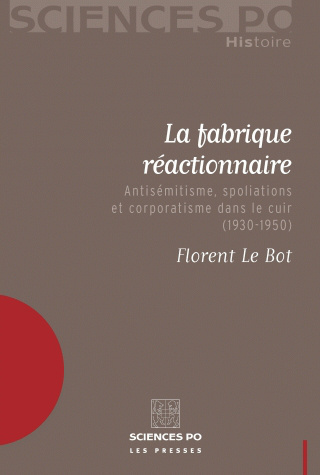La fabrique réactionnaire
Antisémitisme, spoliations et corporatisme dans le cuir (1930-1950)
First Edition
Comment s’élaborent les mécanismes du rejet de l’autre, qu’il soit juif, étranger, concurrent sur le plan économique ? Quelles relations peut-on établir entre crises économiques et crises politiques ? Quel rôle ont exercé les classes moyennes patronales ? Read More
During the Vichy government, anti-Semitic raids impacted approximately 50,000 implicating the involvement of the French administration as well as that of French society as a whole. How does a society establish a policy of exclusion? How does it develop the mechanisms for rejection of the other, whether this other be Jewish, foreign, or an economic competitor ? More important, which ties can be established between economic crises and political crises ? What role did the business-owning middle class play ?
A reactionary process develops itself, builds itself, establishes itself. To describe the steps, the subtleties, the interpretation of facts in relation to this phenomenon, Florent le Bot delves into the world of the leather industry. He reaches into an official report of the involvement of a group of professionals in the pillage of their Jewish counterparts, taking part in a rejection more ancient and more profound than the variations of the economy, attributed since the 1930s to a few large groups designated as "Jews" (the Hunters of André), stigmatized as foreigners (the Bata group), or Jewish artisans of Eastern European origin.
Protectionist demands, xenophobic and anti-Semitic in tone, and the reactionary positions of opposition to industrial modernization, create a line of continuity drawn from the 1930s to the 1950s, this despite restitutions of stolen goods after the war.
Combining political, economic, and social history, this book explains the movements at the very foundation of French society on the eve of the Trente Glorieuses.
Florent Le Bot is a researcher with l'IDHE-CNRS, in charge of the program the University of Évry. His thesis, from which this work came, won the Académie François-Bourdon, Foundation of Arts and Sciences History Prize in 2005.
Specifications
- Publisher
- Presses de Sciences Po
- Author
- Florent Le Bot,
- Preface by
- Michel Margairaz,
- Prize
-
Prix d’histoire de l’Académie François-Bourdon, Fondation Arts et Métiers 2005
- Collection
- Académique
- Language
- French
- Tags
- , , , Antisemitism
- Publisher Category
- > History field > Economic & Social History
- Publisher Category
- > History field > History by period
- Publisher Category
- > History
- Publisher Category
- > History field
- BISAC Subject Heading
- POL000000 POLITICAL SCIENCE
- Onix Audience Codes
- 06 Professional and scholarly
- CLIL (Version 2013-2019)
- 3283 SCIENCES POLITIQUES
- Title First Published
- 06 November 2007
- Subject Scheme Identifier Code
- Thema subject category: Politics and government
Paperback
- Publication Date
- 01 January 2002
- ISBN-13
- 978-2-7246-0875-5
- Extent
- Main content page count : 349
- Code
- 978-2-7246-0875-5
- Weight
- 430 grams
- List Price
- 24.50 €
- ONIX XML
- Version 2.1, Version 3
ePub
- Publication Date
- 01 January 2002
- ISBN-13
- 978-2-7246-8629-6
- Product Content
- Text (eye-readable)
- Extent
- Main content page count : 349
- Code
- 9782724686296
- Technical Protection ebook
- Adobe DRM
- ONIX XML
- Version 2.1, Version 3
Google Book Preview
Contents
Un monde de PME dans lequel viennent « s'immiscer » quelques grands groupes
I - MUTATIONS ET RÉACTION (1930-1939)
Chapitre 1 / LE CUIR ENTRE CRISE ET MUTATIONS
Chapitre 2 / LA « FAMILLE DU CUIR » EN RÉACTION
I I – « ARYANISER » LE CUIR (1940-1944)
Chapitre 3 / UNE OPPORTUNITÉ POUR LA RÉACTION
Chapitre 4 / UNE ENTREPRISE GERMANO-FRANÇAISE D'ÉLIMINATION « RACIALE »
Des tutelles multiples, une responsabilité française
La fabrique de l'« aryanisation »
« Aryanisation », collaboration et ingérences allemandes
Chapitre 5 / SPOLIER N'EST PAS VOLER ?
Chapitre 6 / L'ÉCHEC DE LA RÉACTION INDUSTRIELLE
Conclusion
La fabrique réactionnaire : entre changement de paradigme économique et mise en cause d’un consensus radical
Pour une histoire anthropologique de la civilisation industrielle

